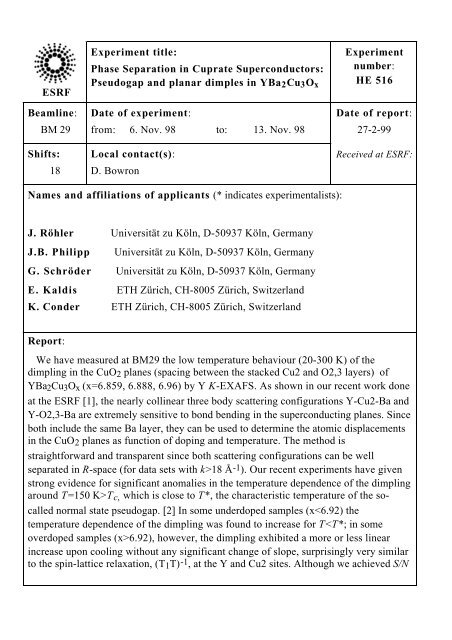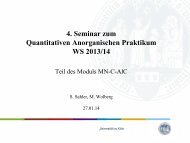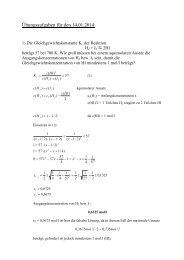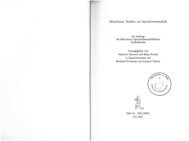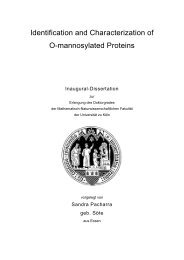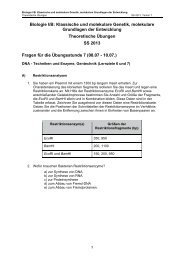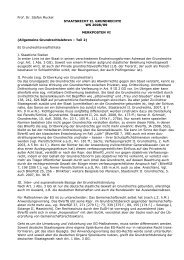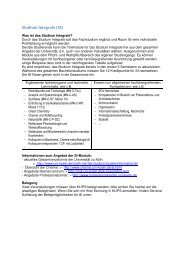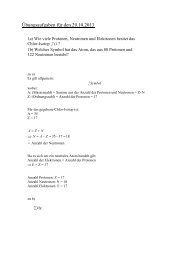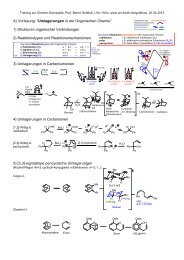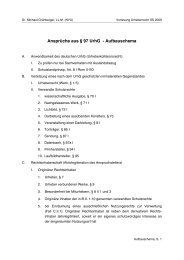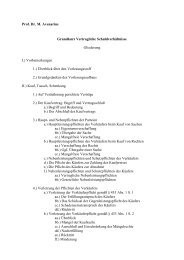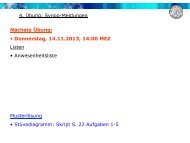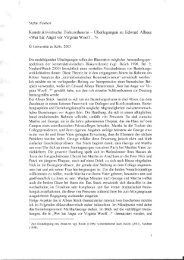ESRF Experiment title: Phase Separation in Cuprate Superconductors
ESRF Experiment title: Phase Separation in Cuprate Superconductors
ESRF Experiment title: Phase Separation in Cuprate Superconductors
You also want an ePaper? Increase the reach of your titles
YUMPU automatically turns print PDFs into web optimized ePapers that Google loves.
<strong>ESRF</strong><br />
Beaml<strong>in</strong>e:<br />
BM 29<br />
Shifts:<br />
18<br />
<strong>Experiment</strong> <strong>title</strong>:<br />
<strong>Phase</strong> <strong>Separation</strong> <strong>in</strong> <strong>Cuprate</strong> <strong>Superconductors</strong>:<br />
Pseudogap and planar dimples <strong>in</strong> YBa2Cu3Ox<br />
Date of experiment:<br />
from: 6. Nov. 98 to: 13. Nov. 98<br />
Local contact(s):<br />
D. Bowron<br />
Names and affiliations of applicants (* <strong>in</strong>dicates experimentalists):<br />
J. Röhler Universität zu Köln, D-50937 Köln, Germany<br />
J.B. Philipp Universität zu Köln, D-50937 Köln, Germany<br />
G. Schröder Universität zu Köln, D-50937 Köln, Germany<br />
E. Kaldis ETH Zürich, CH-8005 Zürich, Switzerland<br />
K. Conder ETH Zürich, CH-8005 Zürich, Switzerland<br />
Report:<br />
<strong>Experiment</strong><br />
number:<br />
HE 516<br />
Date of report:<br />
27-2-99<br />
Received at <strong>ESRF</strong>:<br />
We have measured at BM29 the low temperature behaviour (20-300 K) of the<br />
dimpl<strong>in</strong>g <strong>in</strong> the CuO2 planes (spac<strong>in</strong>g between the stacked Cu2 and O2,3 layers) of<br />
YBa2Cu3Ox (x=6.859, 6.888, 6.96) by Y K-EXAFS. As shown <strong>in</strong> our recent work done<br />
at the <strong>ESRF</strong> [1], the nearly coll<strong>in</strong>ear three body scatter<strong>in</strong>g configurations Y-Cu2-Ba and<br />
Y-O2,3-Ba are extremely sensitive to bond bend<strong>in</strong>g <strong>in</strong> the superconduct<strong>in</strong>g planes. S<strong>in</strong>ce<br />
both <strong>in</strong>clude the same Ba layer, they can be used to determ<strong>in</strong>e the atomic displacements<br />
<strong>in</strong> the CuO2 planes as function of dop<strong>in</strong>g and temperature. The method is<br />
straightforward and transparent s<strong>in</strong>ce both scatter<strong>in</strong>g configurations can be well<br />
separated <strong>in</strong> R-space (for data sets with k>18 Å -1). Our recent experiments have given<br />
strong evidence for significant anomalies <strong>in</strong> the temperature dependence of the dimpl<strong>in</strong>g<br />
around T=150 K>Tc, which is close to T*, the characteristic temperature of the socalled<br />
normal state pseudogap. [2] In some underdoped samples (x
atios close to 10 -4, the still relatively large scatter of the data po<strong>in</strong>ts did not allow for<br />
an unambigous conclusion on a possible relationship between the anomalous<br />
temperature behaviour of the dimpl<strong>in</strong>g, i.e. a lattice anomaly, and the pseudogap<br />
behaviour established by many measurements of the static and dymanic sp<strong>in</strong><br />
susceptibilities. In this run we succeeded to improve the S/N by about one order to 10 -5<br />
of magnitude dur<strong>in</strong>g all shifts, primarily by m<strong>in</strong>imiz<strong>in</strong>g the thermal <strong>in</strong>stabilities of the<br />
monochromator and by further optimiz<strong>in</strong>g the homogeniety of our absorbers. A typical<br />
result from this run (<strong>in</strong> the underdoped regime, x=6.888) is displayed <strong>in</strong> Figs. 1 (left)<br />
Comparison is made with a result from one of the previous runs <strong>in</strong> the overdoped<br />
regime, x=6.94 (right). The now achieved quality of the data is very encourag<strong>in</strong>g now<br />
allow<strong>in</strong>g us to establish from the temperature behaviour of the dimpl<strong>in</strong>g <strong>in</strong> the<br />
conduct<strong>in</strong>g planes the phase separation l<strong>in</strong>e between the pseudo gapped phases and the<br />
"normal" ungapped metallic phases.<br />
Fig. 1 (left, this run) Relative T-dependency of the dimpl<strong>in</strong>g <strong>in</strong> underdoped<br />
YBa2Cu3O6.888. Note the k<strong>in</strong>k at T*=150 K. (Right, previous run) Relative Tdependency<br />
of the dimpl<strong>in</strong>g <strong>in</strong> overdoped YBa2Cu3O6.94. Note the straight l<strong>in</strong>e,<br />
however only with<strong>in</strong> the enhanced noise.<br />
References<br />
[1] J. Röhler, P.W. Loeffen, S. Müllender, K. Conder, E. Kaldis: Local Structure<br />
Studies of the Underdoped-Overdoped Transition <strong>in</strong> YBa2Cu3Ox . Measurement of the<br />
ytttrium X-Ray Absorption-F<strong>in</strong>e-Structure. In: High -Tc Superconductivity 1996.<br />
TenYears after the Discovery, E. Kaldis, E. Liarokapis, and K.A. Müller, eds., NATO<br />
ASI Series,E343, Kluwer, Dordrecht, 1997, pp.469-502.<br />
[2] J. Röhler, S. L<strong>in</strong>k, K. Conder, E. Kaldis: The dimpl<strong>in</strong>g <strong>in</strong> the CuO2 planes of<br />
YBa2Cu3Ox (x=6.806-6984) at T=20-300 K., J. Phys. Chem. Solids, 59, 1925-1928,<br />
1998).


